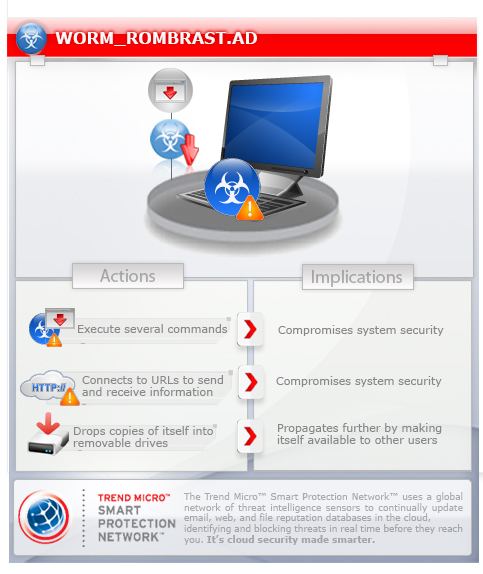WORM_ROMBRAST.AD
Win32/AutoRun.Agent.AGC worm (Eset), W32/Autorun.worm.c (McAfee), Worm:Win32/Rombrast (Microsoft),
Windows 2000, Windows Server 2003, Windows XP (32-bit, 64-bit), Windows Vista (32-bit, 64-bit), Windows 7 (32-bit, 64-bit)


Threat Type: Worm
Destructiveness: No
Encrypted: Yes
In the wild: Yes
OVERVIEW
This worm is an emerging toolkit seen in the black market. It has the potential to be the next hot botnet malware, similar to DORKBOT.
To get a one-glance comprehensive view of the behavior of this Worm, refer to the Threat Diagram shown below.

This worm arrives via removable drives. It arrives on a system as a file dropped by other malware or as a file downloaded unknowingly by users when visiting malicious sites.
It is injected into all running processes to remain memory resident.
It drops an AUTORUN.INF file to automatically execute the copies it drops when a user accesses the drives of an affected system.
It executes commands from a remote malicious user, effectively compromising the affected system. It connects to a website to send and receive information.
It also has rootkit capabilities, which enables it to hide its processes and files from the user.
TECHNICAL DETAILS
Arrival Details
This worm arrives via removable drives.
It arrives on a system as a file dropped by other malware or as a file downloaded unknowingly by users when visiting malicious sites.
Installation
This worm drops the following copies of itself into the affected system and executes them:
- %Application Data%\{random}\{random}.exe
(Note: %Application Data% is the current user's Application Data folder, which is usually C:\Documents and Settings\{user name}\Application Data on Windows 2000, XP, and Server 2003, or C:\Users\{user name}\AppData\Roaming on Windows Vista and 7.)
It drops the following files:
- %Application Data%\{random}\{random}.log
- %Application Data%\{random}\{random}.cfg
(Note: %Application Data% is the current user's Application Data folder, which is usually C:\Documents and Settings\{user name}\Application Data on Windows 2000, XP, and Server 2003, or C:\Users\{user name}\AppData\Roaming on Windows Vista and 7.)
It creates the following folders:
- %Application Data%\{random}
(Note: %Application Data% is the current user's Application Data folder, which is usually C:\Documents and Settings\{user name}\Application Data on Windows 2000, XP, and Server 2003, or C:\Users\{user name}\AppData\Roaming on Windows Vista and 7.)
It is injected into all running processes to remain memory resident.
Autostart Technique
This worm adds the following registry entries to enable its automatic execution at every system startup:
HKEY_LOCAL_MACHINE\SOFTWARE\Microsoft\
Windows\CurrentVersion\Run
{random} = "%Application Data%\{random}\{random},exe"
HKEY_CURRENT_USER\SOFTWARE\Microsoft\
Windows\CurrentVersion\Run
{random} = "%Application Data%\{random}\{random},exe"
Propagation
This worm drops the following copy(ies) of itself in all removable drives:
- {random}_l.exe
- {random}_a.exe
It drops an AUTORUN.INF file to automatically execute the copies it drops when a user accesses the drives of an affected system.
The said .INF file contains the following strings:
[autorun]
open={random}_a.exe
Backdoor Routine
This worm executes the following commands from a remote malicious user:
- Visit URL
- Form Grabber (Chrome, IExplore, Firefox)
- UDP / SYN / Slowloris Flooding
- Download and execute arbitrary files
- Update / Uninstall itself
- DNS Hook
- FTP Grabber
It connects to the following websites to send and receive information:
- {pseudorandom}.{BLOCKED}chsecurity.biz
- {pseudorandom}.{BLOCKED}tversion1.biz
- {pseudorandom}.{BLOCKED}x.biz
Rootkit Capabilities
This worm also has rootkit capabilities, which enables it to hide its processes and files from the user.
NOTES:
This worm drops the following shortcut link in removable drives to load the malware using folder names found on the device:
- {drive letter}:\{folder name}.lnk - detected as LNK_JORIK.SMC
SOLUTION
Step 1
Before doing any scans, Windows XP, Windows Vista, and Windows 7 users must disable System Restore to allow full scanning of their computers.
Step 3
Restart in Safe Mode
Step 4
Scan your computer with your Trend Micro product and note files detected as WORM_ROMBRAST.AD
Step 5
Delete this registry value
Important: Editing the Windows Registry incorrectly can lead to irreversible system malfunction. Please do this step only if you know how or you can ask assistance from your system administrator. Else, check this Microsoft article first before modifying your computer's registry.
- In HKEY_LOCAL_MACHINE\SOFTWARE\Microsoft\Windows\CurrentVersion\Run
- {random} = "%Application Data%\{random}\{random},exe"
- {random} = "%Application Data%\{random}\{random},exe"
- In HKEY_CURRENT_USER\SOFTWARE\Microsoft\Windows\CurrentVersion\Run
- {random} = "%Application Data%\{random}\{random},exe"
- {random} = "%Application Data%\{random}\{random},exe"
Step 6
Search and delete these folders
- %Application Data%\{random}
Step 7
Search and delete AUTORUN.INF files created by WORM_ROMBRAST.AD that contain these strings
open={random}_a.exe
Step 8
Restart in normal mode and scan your computer with your Trend Micro product for files detected as WORM_ROMBRAST.AD. If the detected files have already been cleaned, deleted, or quarantined by your Trend Micro product, no further step is required. You may opt to simply delete the quarantined files. Please check this Knowledge Base page for more information.
Did this description help? Tell us how we did.


